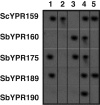Recombination between homoeologous chromosomes of lager yeasts leads to loss of function of the hybrid GPH1 gene
- PMID: 19429545
- PMCID: PMC2704835
- DOI: 10.1128/AEM.00351-09
Recombination between homoeologous chromosomes of lager yeasts leads to loss of function of the hybrid GPH1 gene
Abstract
Yeasts used in the production of lagers contain complex allopolyploid genomes, resulting from the fusion of two different yeast species closely related to Saccharomyces cerevisiae and Saccharomyces bayanus. Recombination between the homoeologous chromosomes has generated a number of hybrid chromosomes. These recombination events provide potential for adaptive evolution through the loss or gain of gene function. We have examined the genotypic and phenotypic effects of one of the conserved recombination events that occurred on chromosome XVI in the region of YPR159W and YPR160W. Our analysis shows that the recombination event occurred within the YPR160W gene, which encodes the enzyme glycogen phosphorylase and generates a hybrid gene that does not produce mature mRNA and is nonfunctional due to frameshifts in the coding region. The loss of function of the hybrid gene leads to glycogen levels similar to those found in haploid yeast strains. The implications for the control of glycogen levels in fermentative yeasts are discussed.
Figures





Similar articles
-
Chapter 6: The genomes of lager yeasts.Adv Appl Microbiol. 2009;69:159-82. doi: 10.1016/S0065-2164(09)69006-7. Adv Appl Microbiol. 2009. PMID: 19729094 Review.
-
Genome sequence of the lager brewing yeast, an interspecies hybrid.DNA Res. 2009 Apr;16(2):115-29. doi: 10.1093/dnares/dsp003. Epub 2009 Mar 4. DNA Res. 2009. PMID: 19261625 Free PMC article.
-
Recombination sites on hybrid chromosomes in Saccharomyces pastorianus share common sequence motifs and define a complex evolutionary relationship between group I and II lager yeasts.FEMS Yeast Res. 2017 Aug 1;17(5). doi: 10.1093/femsyr/fox047. FEMS Yeast Res. 2017. PMID: 28899033
-
Expression of the yeast glycogen phosphorylase gene is regulated by stress-response elements and by the HOG MAP kinase pathway.Yeast. 2001 Dec;18(16):1505-14. doi: 10.1002/yea.752. Yeast. 2001. PMID: 11748727
-
The complex and dynamic genomes of industrial yeasts.FEMS Microbiol Lett. 2009 Apr;293(1):1-10. doi: 10.1111/j.1574-6968.2008.01480.x. Epub 2009 Jan 17. FEMS Microbiol Lett. 2009. PMID: 19175410 Review.
Cited by
-
Yeast evolutionary genomics.Nat Rev Genet. 2010 Jul;11(7):512-24. doi: 10.1038/nrg2811. Nat Rev Genet. 2010. PMID: 20559329 Review.
-
Evidence for suppression of immunity as a driver for genomic introgressions and host range expansion in races of Albugo candida, a generalist parasite.Elife. 2015 Feb 27;4:e04550. doi: 10.7554/eLife.04550. Elife. 2015. PMID: 25723966 Free PMC article.
-
Whole Genome Sequencing, de Novo Assembly and Phenotypic Profiling for the New Budding Yeast Species Saccharomyces jurei.G3 (Bethesda). 2018 Aug 30;8(9):2967-2977. doi: 10.1534/g3.118.200476. G3 (Bethesda). 2018. PMID: 30097472 Free PMC article.
-
Chromosomal Copy Number Variation in Saccharomyces pastorianus Is Evidence for Extensive Genome Dynamics in Industrial Lager Brewing Strains.Appl Environ Microbiol. 2015 Sep;81(18):6253-67. doi: 10.1128/AEM.01263-15. Epub 2015 Jul 6. Appl Environ Microbiol. 2015. PMID: 26150454 Free PMC article.
-
Sequencing and characterisation of rearrangements in three S. pastorianus strains reveals the presence of chimeric genes and gives evidence of breakpoint reuse.PLoS One. 2014 Mar 18;9(3):e92203. doi: 10.1371/journal.pone.0092203. eCollection 2014. PLoS One. 2014. PMID: 24643015 Free PMC article.
References
-
- Bond, U., and A. Blomberg. 2006. Principles and applications of genomics and proteomics in the analysis of industrial yeast strains, p. 175-213. In A. Querol and G. Fleet (ed.), The yeast handbook. Yeasts in food and beverages. Springer-Verlag, Heidelberg, Germany.
-
- Bond, U., C. Neal, D. Donnelly, and T. C. James. 2004. Aneuploidy and copy number breakpoints in the genome of lager yeasts mapped by microarray hybridisation. Curr. Genet. 45:360-370. - PubMed
-
- Caesar, R., J. Palmfeldt, J. S. Gustafsson, E. Pettersson, S. H. Hashemi, and A. Blomberg. 2007. Comparative proteomics of industrial lager yeast reveals differential expression of the cerevisiae and non-cerevisiae parts of their genomes. Proteomics 7:4135-4147. - PubMed
Publication types
MeSH terms
Substances
Associated data
- Actions
LinkOut - more resources
Full Text Sources
Molecular Biology Databases

